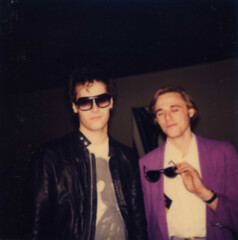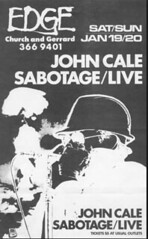Pat Ivers and Emily Armstrong continue sorting through their archives of punk-era concert footage as it’s digitized for the Downtown Collection at N.Y.U.’s Fales Library.
Five Favorite Facts about John Cale:
- He studied musicology at London’s Goldsmiths College in the early 1960s, where his teachers dubbed him “Most Hateful Student” before awarding him a prestigious Leonard Bernstein scholarship to study with the Boston University Orchestra.
- He appeared on the game show “I’ve Got A Secret” in 1963. His secret: participating in the New York performance of an Erik Satie piece that ran for more than 18 hours.
- He composed the soundtrack for the prison sexploitation flick “Caged Heat,” Jonathan Demme’s 1974 directorial debut.
- He decapitated a dead chicken on stage in 1977 in Croydon, prompting two vegetarian members of his band to walk off. (He had vegetarian musicians in his band?)
- He produced Patti Smith, Happy Mondays and Siouxsie and the Banshees, as well as Jennifer “I Had the Time Of My Life” Warnes’ third album, “Jennifer.” Impossible to find and never reissued, it’s probably genius.
Well, that’s a start. It is impossible to sum up John Cale in 700 words. Seven million wouldn’t be enough. Would there have been a Downtown music scene without the Velvets and John Cale? Maybe, but it sure would have been different. He is an artist who has never stopped experimenting, never stopped reaching. He is fearless, complex, breathtakingly brilliant, exhausting, and inexhaustible.
In January, he appeared at the Brooklyn Academy of Music, revisiting his 1973 album “Paris 1919” and curating a tribute to Nico, “Life Along the Boarderline.” This summer, he will be playing the Green Man Festival in Wales with Band of Horses and The Swans. Like that other Welshman, at 71, he has no intention of going gently.
We were lucky enough to capture this show in 1979 at Irving Plaza, during his Sabotage tour. Backup singer Deerfrance remembers, “He asked me to join the band — I got into a station wagon one night and we never stopped touring for the next two years.” She, along with keyboardist Joe Bidewell, were core members for the duration, with guitarists, drummers and bass players rotating in and out for year long stretches. Guitarist Sturgis Nikides, bassist Peter Muny and drummer Robert Medici round out this iteration of the band. At the height of punk, with two-minute songs in fashion, Cale’s band was playing tough bluesy rock with long jammy interludes. Bidewell describes their rehearsal technique as Joycean: “It was like stream of consciousness. We would play and go with what happened, to a place not connected with logic. John would listen to the tapes we made and figure what worked and we would go from there.”
Watch and listen to the clip of their cover of Rufus Thomas’s, “Walking the Dog.” “John was an incredible band leader,” drummer Medici said. “He loved a muscular riff like the one in that song. He would use the band to support it and then improvise around it. He liked musicians who were secure enough to follow his lead and be diverted at the same time. With him, the band became greater than the sum of its parts.” It is not a stretch to see the influence of avant-garde composer La Monte Young, whose use of long tones and high volume shaped Cale from the start. Cale just took it to rock and roll.
If you look carefully at the clip, you can see that Cale is wearing a cast under his surgical scrubs. No one can really recall why – which is not entirely surprising, given the grind of touring and the band’s “show must go on” work ethic. “John and the band would do anything to make a set work,” Deerfrance recalls. “It was thrilling.”
After the tour, Nikides, Muny and Medici stayed on to record the album, “Honi Soit” in 1981. Not one to rest on his laurels, that same year Cale performed his unrecorded song cycle, “The Nine Lives of Gordon Liddy,” and produced albums for the likes of Pat Paladin and Judy Nylon and Modern Guy.
“John was so vital, he could go for 24 hours,” Deerfrance recalls. Medici agrees. “He was an artist and a gentleman. For all his over the top behavior, he could take the grittiness of New York and turn it into art.”
Deerfrance gets the last word: “He was generous and mercurial and a musical genius.” When the book on downtown is written, she speculates, it would read, “Lou Reed gave the Velvets street cred but John Cale gave them depth and wings and vision.”
And in 2013, he ain’t done yet.







